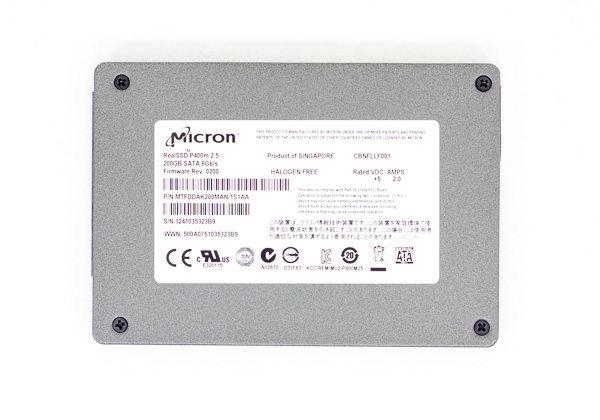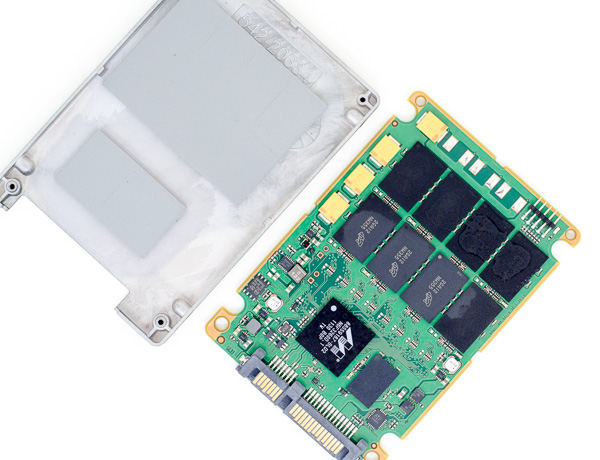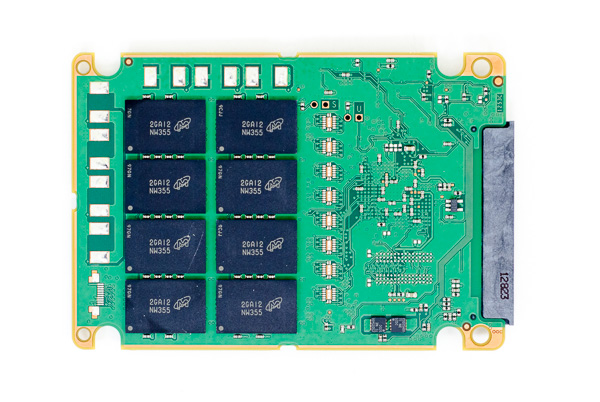Micron P400m Review (200GB)
by Anand Lal Shimpi on February 13, 2013 12:00 AM ESTMicron has remained one of the more stable players in the SSD space over the past few years. Although not typically at the top of our charts, Micron (and its consumer brand, Crucial) have generally paired the latest in NAND technology with custom firmware that’s well validated. It sounds like a simple combination, but it’s so rarely found in an industry that’s growing quickly enough to both those that are first to market as well as those that are most reliable.
Lately, Micron has been trying to make more of a splash in the market. Earlier this year it announced the first consumer SSD to feature 128Gbit MLC NAND die, the M500. Through aggressive pricing on its end, Micron hopes to be able to deliver a 960GB M500 for less than $600. Whether or not this is realistic remains to be seen, but the fact of the matter remains that this is a level of aggression we hadn’t seen previously from Micron.
On the enterprise front, Micron is looking to fill a gap in its product lineup. In the 2.5” SATA form factor, Micron really only had two offerings: the dated SLC-based P300, and the entry level P400e. The former was built for a market that has increasingly moved to high-endurance MLC NAND, while the latter wasn’t robust enough to deal with any of the more write-heavy enterprise environments. Filling the gap is the drive we’re looking at today: Micron’s P400m.
| Micron P400m | ||||||
| Advertised Capacity | 100GB | 200GB | 400GB | |||
| NAND | 25nm Micron XPERT MLC NAND | |||||
| Sequential Read/Write | 380/200 MBps | 380/310 MBps | 380/310 MBps | |||
| Random Read/Write | 52K/21K IOPS | 54K/26K IOPS | 60K/26K IOPS | |||
| Price | TBD | TBD | TBD | |||
Like many Micron drives before it, the P400m uses a Marvell controller coupled with Micron developed firmware and Micron manufactured NAND. For the uninitiated, Intel and Micron have a joint venture (IMFT) that produces NAND which is then used by both companies as well as sold to others. Allegedly, Intel and Micron save the best NAND for themselves, giving them a slight edge in the endurance department (I’ll get to this momentarily).
The P400m features Marvell’s latest high-end SATA to NAND Flash controller, the 88S9187. The P400e before it used the 889174. These part numbers should look pretty familiar as they’ve been used by everyone from Intel to Plextor. The differentiation in the firmware, validation and NAND of course.
The 9187 controller is passively cooled, but Marvell slapped a thermal pad on the chip to help use the drive’s 7mm chassis to dissipate heat. Adjacent to the controller is a 256MB DDR3-1333 DRAM for firmware and indirection table caching.
The P400m is available in three capacities: 100GB, 200GB and 400GB. Micron sent along a 200GB model, which features sixteen NAND packages. A quick look at the part numbers reveals something interesting however: there’s no known record of the 2-bit-per-cell MLC NAND used on this P400m.
Micron has an explanation: the P400m uses Micron’s custom 25nm MLC NAND that isn’t available for purchase by other vendors. It’s called XPERT (eXtended Performance and Enhanced Reliability Technology), and is akin to Intel’s MLC with High Endurance Technology. The P400m’s XPERT NAND leverages a handful of technologies that we’ve seen before in enterprise drives. Micron does some DSP-like work on the NAND over time to compensate for drift in cell read/program voltages. There’s a RAID 5-like redundancy algorithm in effect across all NAND channels. Finally, Micron performs CRC and ECC checks on all memories in the P400m’s data path.
The P400m uses NAND binned for endurance. Micron also does its own testing on the NAND to weed out any premature failures.
Like many other enterprise SSDs targeted at write heavy workloads, the P400m features a lot of spare area. The 200GB sample Micron sent over features 16 NAND packages. Decoding the part number on each package tells us that we’re dealing with four 25nm MLC NAND die per package. The capacity per die is unique at 42Gbit. Doing the math we end up with 336GiB of NAND on a 200GB P400m.
| Micron P400m Endurance | ||||||
| Advertised Capacity | 100GB | 200GB | 400GB | |||
| Total NAND On-board | 168 GiB | 336 GiB | 672 GiB | |||
| User Capacity in GiB | 93.1 GiB | 186.3 GiB | 372.6 GiB | |||
| Rated Endurance (Drive Writes per Day) | 10DW per day x 5 years |
10DW per day x 5 years |
10DW per day x 5 years |
|||
| Endurance in PB | 1.75 PB | 3.0 PB | 7.0 PB | |||
This is a lot more NAND than you get with Intel’s S3700, and even more than Intel shipped on the 710. The added NAND helps keep write amplification low, and endurance up. The P400m is rated for between 1.75PB - 7PB total writes over the lifetime of the drive. These ratings are determined using worst case write amplification (full span 4KB random writes), so many workloads will see even better longevity out of the drive.
Micron added power loss protection to the P400m. The company claims that all writes in flight will be committed to NAND in the event of sudden power failure.
| Intel's SSD DC S3700 vs. Micron P400m (200GB) | ||||||
| Intel | Micron | |||||
| Advertised Capacity | 200GB | 200GB | ||||
| Total NAND On-board | 264 GiB | 336 GiB | ||||
| User Capacity in GiB | 186.3 GiB | 186.3 GiB | ||||
| Sequential Read/Write | 500 / 460 MBps | 380 / 310 MBps | ||||
| Random Read/Write | 75K / 32K IOPS | 54K / 26K IOPS | ||||
| Endurance in PB | 3.65 PB | 3.0 PB | ||||
| MSRP | $470 | TBD | ||||
In many senses the P400m is Micron’s answer to Intel’s S3700. Update: Micron tells us that the initial pricing guidance on the P400m was incorrect. Micron isn't providing updated pricing information at this time, other than to say it will be competitive.













23 Comments
View All Comments
JarredWalton - Wednesday, February 13, 2013 - link
I'm not sure what causes it, but periodically when an article posts the Like button is broken and basically "maxes out". I don't know where the 1394 number comes from (not FireWire! Hahaha), but I'll pass the info to John, our web guy, to see if he can do something about it. It was supposed to be fixed....Beenthere - Wednesday, February 13, 2013 - link
Tell that to those with the "100 hour crash" syndrome...All of the SSD makers have been rushing half-baked products to market for huge profits from gullible consumers duped by the media. With Smasungs SSD and now PC issues, it's pretty safe to conclude that quite a few of the brand name SSD suppliers are cashing in on half-baked crap.
Death666Angel - Wednesday, February 13, 2013 - link
Was he saying that they never have issues with their SSDs? No, that's what the "more" indicates (more stable than competition, not absolutely, 100% stable all the time).And just because there are issues doesn't mean things are half baked, in my opinion. Everything can have issues, even centuries old technology or stuff they through countless man-hours and money at. I personally owned 3 SSDs (Agility, Vertex2, 840 non-Pro), all working fine to this day. I owned a Samsung laptop, smartphone, tablet, all fine. Am I saying that everything with them is fine? No. But there is no point in being a doom-sayer like you at the moment either.
Mr Perfect - Wednesday, February 13, 2013 - link
Don't mind him, he posts something similar in every SSD related article regardless of make or model.Death666Angel - Wednesday, February 13, 2013 - link
Thanks I'll note his name for ignoring in the future :P.JellyRoll - Wednesday, February 13, 2013 - link
The whole thing looks great (with the exception of Anand making some very major flaws listing the design of the unit) until the very end where he essentially says, "buy intel", even though they have nowhere near the features of the P5400m. I am wondering how he came to that conclusion.melgross - Wednesday, February 13, 2013 - link
I don't recall him saying that. He mentioned price performance. This performs somewhat worse than the Intel drive, so he said that if it were less expensive, it would be worth looking at, but that if it were more expensive, then the Intel drive would be a better bet. Since micron's pricing is pretty high, as given, though they told him the pricing was wrong, we don't know the pricing.I think his closing remarks were right on the money, so to speak.
Are you sure you understood what he said?
Mr Perfect - Wednesday, February 13, 2013 - link
I'm assuming that the endurance rating "DW" is referring to drive-writes a day? Meaning "10DW x 5 years" is ten complete drive writes a day for five years?Anand Lal Shimpi - Wednesday, February 13, 2013 - link
Correct, I will clarify in the table.Take care,
Anand
zeadlots - Wednesday, February 13, 2013 - link
Is it just me or do the graphs on the second page feature the Samsung 840pro SSD, but the subsequent graphs all have the Samsung SM825. It was my understanding that the 840pro was top 3 on most tests according to another article of yours. Hoping someone can doublecheck this.